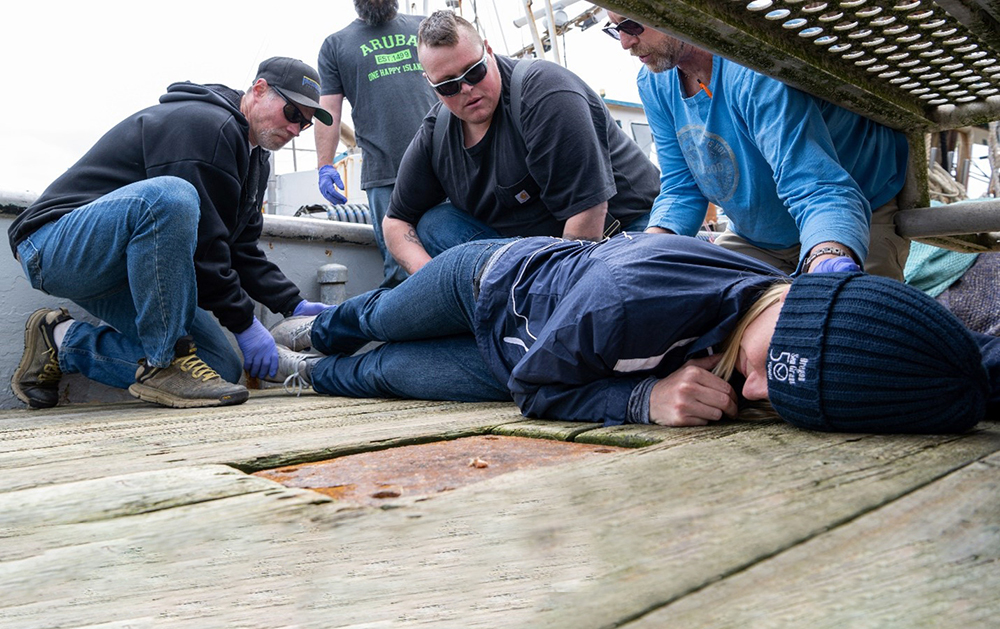
You’re a Dungeness crab fisherman. It’s 4:30 p.m. on a cold and rapidly darkening January day. It has been a great day, with a catch like you have never seen. You and your crew are pulling the last of your pots when you look over and see one of your crew not looking right.
A crew member is standing near the winch with his left arm bending the wrong direction. He’s not saying anything, but he’s wet and starting to shiver. You are 30 miles offshore and even further back to port. The seas are building, winds picking up and the clouds are dropping.
This scenario is part of Fishermen First Aid Safety Training (FFAST), developed by Oregon State University (OSU) and Oregon Sea Grant, to address the specific first aid needs of commercial fishermen responding to workplace injuries on their vessels.
Fishing Safety Grants
Funding for delivering FFAST comes from the Commercial Fishing Occupational Safety Research &
Training Program, administered jointly by the United States Coast Guard (USCG) and the Centers for Disease Control’s National Institute for Occupational Safety and Health (NIOSH). This grant program offers $6 million in funding each year to eligible organizations to advance fishing safety research and provide targeted, regionally appropriate training for the nation’s commercial fishermen.
FFAST project manager and Oregon Sea Grant employee Amanda Gladics says the need for the FFAST program came out of conversations with partners in Pacific Northwest coastal communities who were required by the USCG to have first aid and CPR training, but often found that training wasn’t applicable to fishermen.
“The answer was always, “Call 9-1-1,” Gladics said, “but in many cases those resources aren’t available. Even with a helicopter response you’re at least 60 minutes from having those resources arrive.”
Oregon Sea Grant saw an opportunity and applied to the Commercial Fishing Occupational Safety Research & Training Program.
“The goal was to create a first aid training program with content and scenarios that were relevant to the type of fishing we have on the West Coast,” Gladics explained.
The curriculum goes beyond standard community first aid and covers fishing-specific scenarios as well as topics such as scene assessment, communicating with medical personnel and taking vital signs. The curriculum is shared with safety training groups such as the Alaska Marine Safety Education Association in the Northwest and Alaska as well as Fishing Partnership Support Services on the East Coast.
Oregon Sea Grant is also collaborating with Washington and California Sea Grant to share the training resources and opportunities more broadly on the West Coast.
“These projects are making a difference in fishermen’s lives,” NIOSH Associate Director of Agriculture Safety and Health Jennifer Lincoln said. “Research and training need to be relevant and practical for vessel owners and crew.”
Becoming a Safety and Research Grantee
When asked how other groups can take advantage of this funding opportunity, OSU researcher Dr. Laurel Kincl advises them not to be afraid to ask current grantees about their past applications and the process.
“I think people are pretty amenable to sharing tips and strategies,” she said.
The Commercial Fishing Occupational Safety Research & Training Program has two application deadlines each year, with the next one coming up Aug. 29.
NIOSH staff are raising awareness of this funding opportunity.
“These projects are making a difference in fishermen’s lives. Research and training need to be relevant and practical for vessel owners and crew,” Lincoln said.
Fishing associations, universities, training organizations, municipalities, tribal organizations and fishing businesses are all eligible to apply for these funds.
If you are interested in learning more about the Commercial Fishing Occupational Safety Research & Training Program, visit the website, https://tinyurl.com/mve457ez, or read the FAQ, https://www.cdc.gov/niosh/oep/commercial-fishing-research-training/FAQ.html.
For more information on the Fishermen First Aid Safety Training Program, visit the Oregon Sea Grant website, https://tinyurl.com/5n7szt9y.
The Alaska Marine Safety Education Association (AMSEA) has a mission is to reduce injury and death in the marine and freshwater environment through education and training provided by a network of marine safety instructors. The Sitka, Alaska-based organization has been offering marine safety training to commercial fishermen and thousands of other mariners since 1985.
More information on marine safety topics can be found at www.amsea.org
